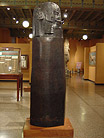Ethnicity and Language
Ancient Mesopotamia was located in what is today modern Iraq. During its long history, Mesopotamia saw the influx of many different ethnic groups who both assimilated and integrated some of their own beliefs and customs into the native society. Rather than identifying themselves against “non-Mesopotamians,” ancient Mesopotamians made more of a distinction between people they considered to be civilized, that is, settled people who lived in towns and cities, and those they considered to be uncivilized, that is, nomads who lived in the steppe and had “barbaric” customs. Although ancient Mesopotamians appear to have been quite welcoming of other peoples—in contrast to such places as Egypt—Mesopotamian culture was generally quite conservative, with the same basic culture remaining throughout its history.
Mesopotamia was divided up into different polities that changed over time. Early on, the southern part of Mesopotamia was divided into a northern area, Akkad (roughly from 60 km north to 150 km south of modern Baghdad), and a southern area, Sumer (roughly from the Persian Gulf up to 160 km south of modern Baghdad). Later on, this area came to be called Babylonia, and it was differentiated from its northern neighbor—also a part of what we call Mesopotamia—called Assyria.
Archaeological evidence of civilization in ancient Iraq points to the Sumerians as the earliest known inhabitants of southern Mesopotamia; however, as soon as history begins—with writing (ca. 3200 BCE)—it is clear that the culture was already a mixed one, with a Semitic people also inhabiting the area along with the Sumerians. These Semitic people spoke a language called Akkadian, which was related to Hebrew and Arabic, among other Semitic languages. Sumerian was completely unrelated to Akkadian; indeed, it is related to no other known languages, and so is labeled a linguistic isolate. From the earliest textual sources it is clear that Mesopotamian culture was a Sumero-Akkadian one, and that the inhabitants were bilingual, speaking both languages side by side. The Akkadians very early on even adopted the cuneiform script, invented by Sumerian speakers, to write their own language. Probably by early in the second millennium the Akkadian language became predominant and Sumerian died out as a spoken language, although it remained as a scholarly language throughout Mesopotamian history.
Other ethnic groups, distinguished from native Mesopotamians mainly by their language (often identified only by their names), but sometimes also by distinctive customs, arrived in several waves over the next several thousand years. A group called the Amorites came from the west and eventually became such prominent members of society that they formed a ruling dynasty in Babylonia. The most famous king of this dynasty was Hammurabi. While bringing about certain minor changes in the religio-political landscape, the Amorites for the most part became regular Mesopotamian citizens, adopting the native belief system. And, although they were often identified as Amorites in textual sources, this does not appear to have been in any way derogatory.
The Kassites were another group of people who entered Mesopotamia and eventually ruled over Babylonia. Like the Amorites, they introduced some of their own beliefs—in this case, adding some of their own deities to the existing pantheon of gods—but basically assimilated to the native culture. The Arameans moved in later from the west, during the first millennium, and also became rulers of Babylonia. Eventually, during the first millennium, their language, which was written alphabetically, like Hebrew, became predominant.
Other groups of people speaking their own languages who came into close contact with Mesopotamians were the Gutians from the Zagros Mountains to the northeast, who appeared at the end of the third millennium and spoke a language which, like Sumerian, is a linguistic isolate. There were also the Hittites from Anatolia (modern Turkey) who spoke an Indo-European language, and the Hurrians, located mainly in the northwest, who spoke a language that may have been related to another ancient language called Urartian. Finally, in the neighboring Iranian plateau, the Elamite-speaking people had a long history of contact with Mesopotamia, with alternating times of conflict and peace between the two polities.

 Jennie Myers
Jennie Myers
Research Associate, University of Chicago
Guiding Questions
1. How did ancient Mesopotamian cultures reflect the concept of “assimilation”?
2. How did geographic factors, particularly mountains and bodies of water, factor into the blending, or, in some cases, the lack thereof, of cultures in ancient Mesopotamia?
3. How does the polytheism of ancient Mesopotamia reflect political, social, and economic systems based on family ties?


 Print Page
Print Page


